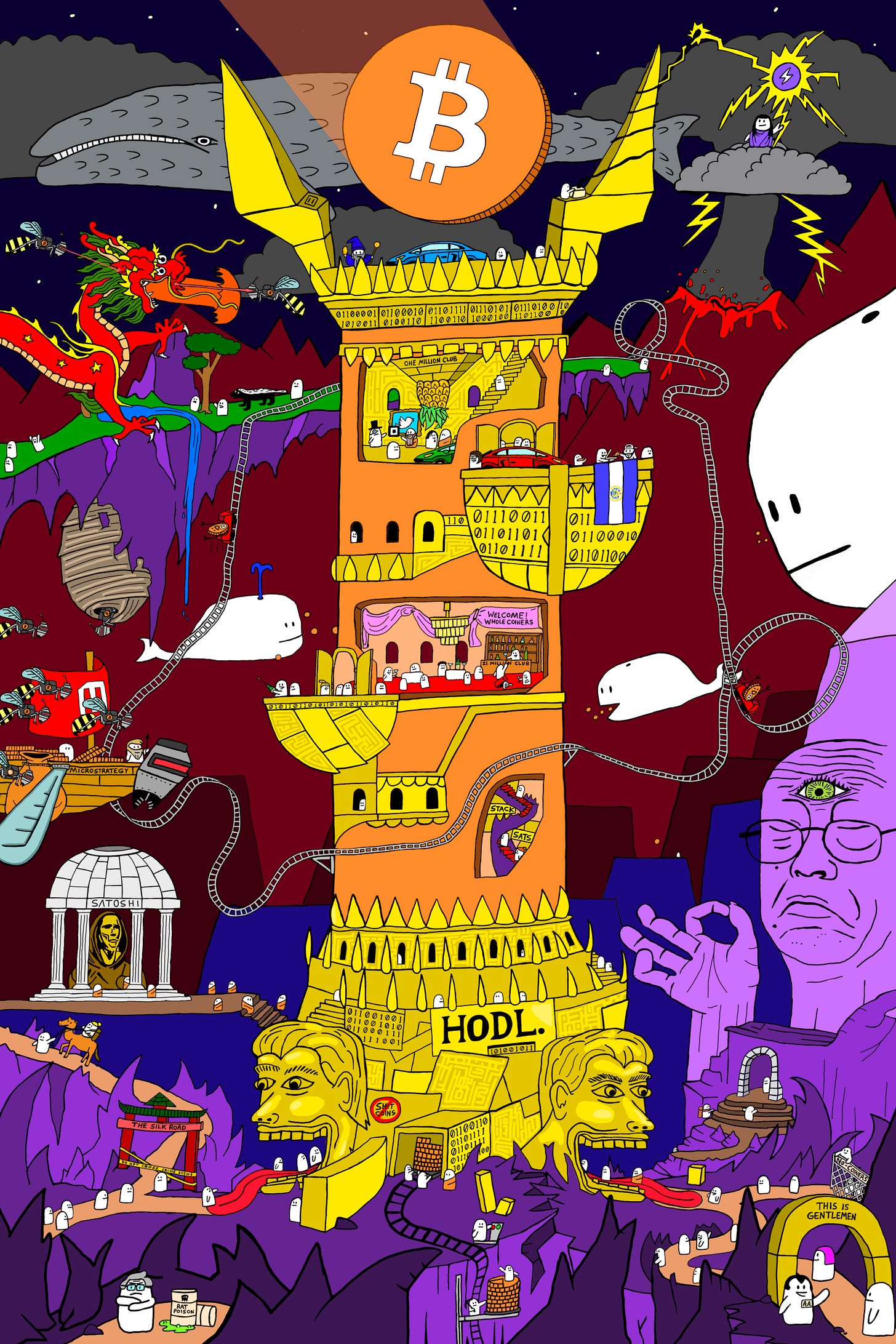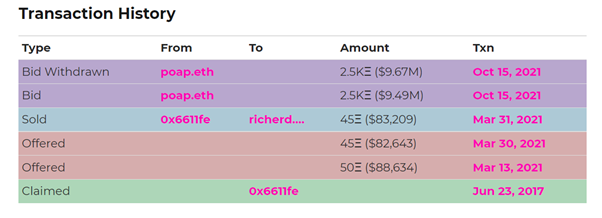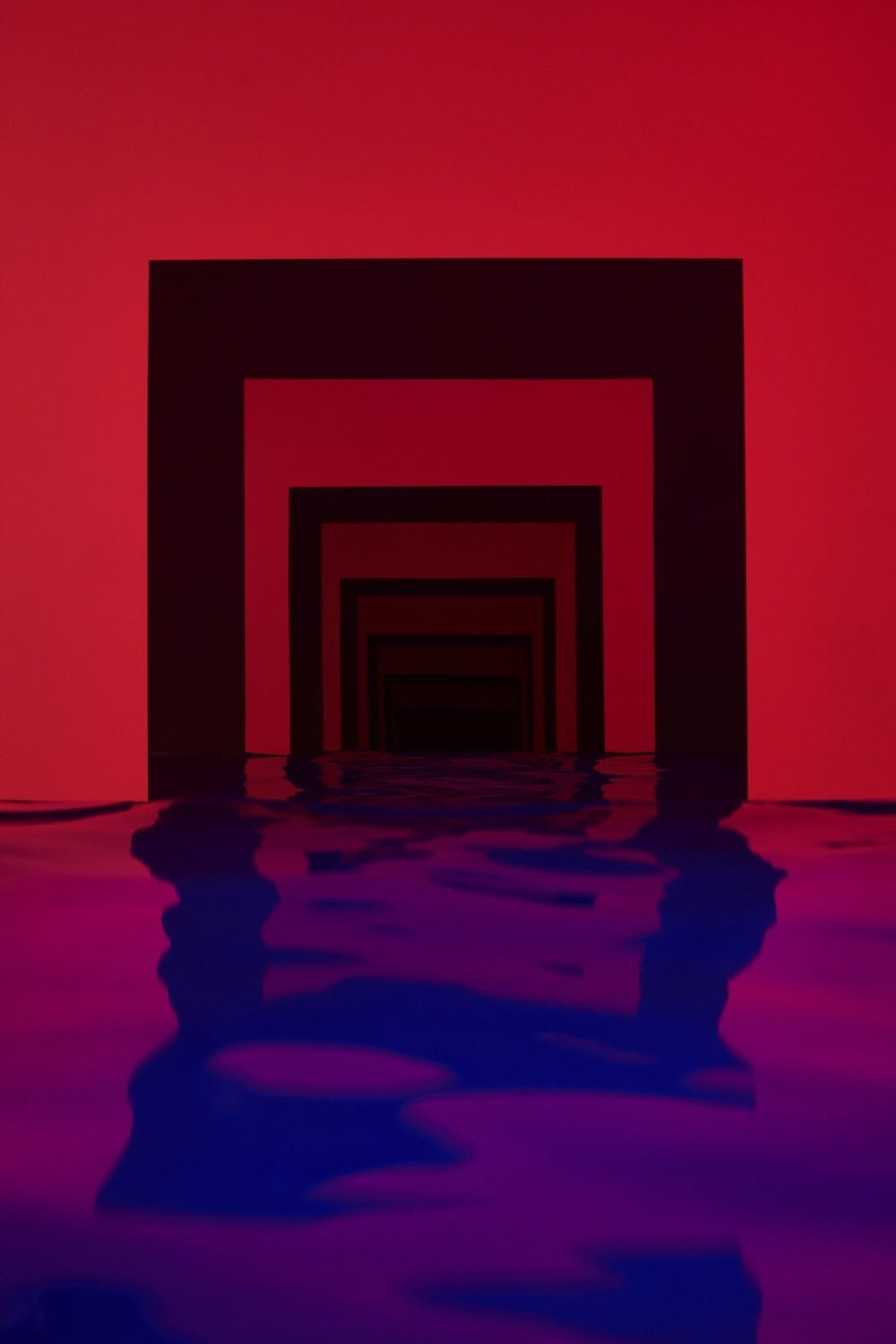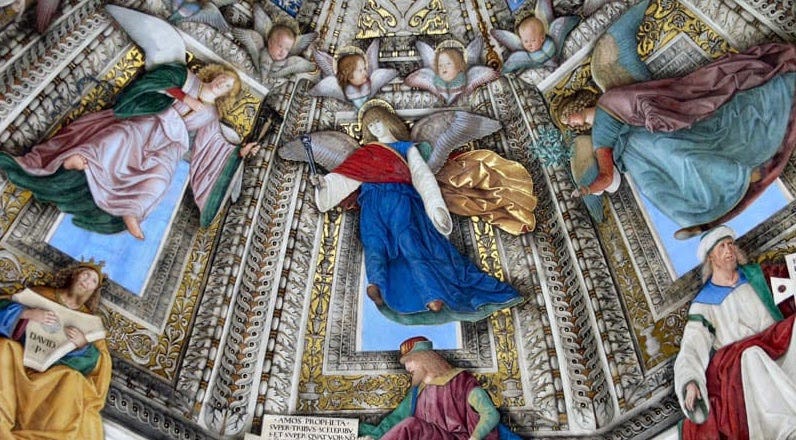Decentralized Arts #9 | October 18
BanklessDAO Weekly NFT and Cryptoart Newsletter
Dear Bankless Nation,
In this issue we greet our sponsor, Perpetual Protocol, who discusses their NFT giveaway collection. We introduce Sarah Meyohas, a conceptual artist whose financial background has strongly directed her vision of art and her closeness to the crypto world. She’s an artist who first anticipated NFTs and who uses the most current technological tools—such as generative algorithms, artificial intelligence and virtual reality—with mastery and creativity. Art coexists and is thus perpetuated not only with technology but also with financial instruments.
In all this, an artist whose name is now synonymous with BanklessDAO, Perchy, could not be missing.
Welcome to Decentralized Arts.
Authors: BanklessDAO Writers Guild (Grendel, Kouros, Gioser, nonsensetwice)
This is the official NFT newsletter of the Bankless DAO. If you were a Premium Member of the Bankless Newsletter as of May 1st 2021 you have been subscribed to this newsletter at launch. To unsubscribe edit your settings here.
Artist of the Week
🧑🎨 Artist: Perchy
🏦 Auction Type: Open Edition, 420
💰 Price: 0.025 ETH
The Citadel, by Perchy
To quote David Hoffman: “Crypto culture is tight.”
A large part of my artistic mission is to illustrate my interpretation of crypto culture. If you’re reading this, you probably already know that crypto culture is far from a monoculture. The two largest crypto communities—Bitcoin and Ethereum—have vastly different cultures surrounding them. “The Citadel,” the second piece in my Bankless Locations series, is an homage to everything Bitcoin.
I love Bitcoin. It was the first cryptocurrency to exist, and it was the first cryptocurrency I owned. I love the ethos behind it and its mysterious, almost divine, creation story.
The story of the Bitcoin Citadel is one of the oldest Bitcoin memes there is. I believe that it emerged many years ago on the bitcointalk forum on reddit. It’s based around the idea that one day the global economy will collapse, and only bitcoin will have value. All of those lucky enough to have accumulated enough bitcoin will be allowed to live a life of luxury in The Citadel. The meme usually doesn’t dwell on what happens to the rest of the world in this scenario, but we can assume it’s nothing good. The whole concept is pretty dystopian and depressing, but also darkly evocative and imaginative. As someone who is drawn to dystopian literature, the imagery of this spoke to me.
This is not to say that Bitcoiners believe or want the citadel meme to happen in reality. In my opinion, the meme comes as the logical result of seemingly endless fiat money printing. From this lens, Bitcoiners did not create the economic predicament we find ourselves in. They are merely reacting to a bad situation by stockpiling bitcoin.
The citadel meme comes from the more libertarian side of the Bitcoin community, which is sometimes how Bitcoiners as a whole are characterized. I’ve been lurking for many years in the Bitcoin community. There are politically left wing, progressive Bitcoiners, just as there are centrists, as well as the more right wing, libertarian, and anarchist types. We Bitcoiners are an odd, ideologically diverse bunch.
Curated NFT News
Coinbase to launch a NFT marketplace
The cryptocurrency exchange revealed the news through a blog post on October 12, noting that the peer-to-peer marketplace for digital art, named Coinbase NFT, will be ready before the end of 2021.
The company has offered users the option to join a waitlist that will get them early access. As of Thursday morning, the waiting list had 1.35 million applications, which is four times the users of Open Sea, the world’s largest NFT marketplace.
In a statement, Sanchan Saxena, VP of Product and Ecosystem at Coinbase, added that this marketplace will make minting, purchasing, showcasing and discovering NFTs easier than ever. Just as Coinbase helped millions of people access Bitcoin for the first time in an easy and trusted way, they want to do the same for the NFTs.
2,500 ETH bid for Crypto Punk #6046
Last week the surprise offer was placed by poap.eth to buy this CryptoPunk and if accepted this would have been the highest CryptoPunk sales so far in USD$. Currently the highest sale to date is Punk #3100 for 3.2K ETH ($7.58M) on March 11 2021.
This sale would have been $9.49M, however richerd, the owner of Punk #6046, has rejected the offer advising that his Punk is not for sale and adding: “My identity along with identity of other iconic Punks and apes have value beyond the NFT itself. We have our own brands similar to any other brand and that has value. Because I value my personal brand and identity, this was an easy rejection for me.”
After richerd’s statement the bid was withdrawn.
Perpetual Protocol NFT giveaway collection
While they are working hard to launch Perp v2, Perpetual Protocol has prepared a series of NFTs designed by CC: creator of the famous videos for FTX and Sushiswap! The launch is intended to excite the community about Perp v2 and thank them for their support.
Sarah Meyohas, an Artist Cutting a Path Through
by Grendel
Sarah Meyohas, is a conceptual artist whose practice considers the nature and capabilities of emerging technologies in contemporary society. Using the familiar emblems of biological life, Meyohas investigates the complex operations that increasingly govern our world: soaring birds, created using augmented-reality software, flock in unison with the frenetic variations of the stock market; rose petals, aggregately identical but individually unique, comprise the dataset for their AI-created equivalents; Bitchcoin, a cryptocurrency backed by physical artworks, questions the speculative value of cryptocurrency and the ineffable value of art. Meyohas creates an intelligible visual language to articulate the systems and technologies that increasingly influence our world.
GR: How did you become a cryptoartist?
SM: By virtue of my training, I studied finance at the University of Pennsylvania, in Wharton. I went to Yale for a Masters in Fine Arts where I studied photography. Consequently, I was very interested and, being in graduate school, I tried to absorb the theory. I read a lot about what I was thinking a lot about, which is what the concept of value is. Financially you can look at value in a certain mode, but artistically, culturally, spiritually, value can be something entirely different. I was trying to reconcile the various aspects because the truth is that they are not separate concepts. The economy can also be very symbolic. Value appears only in the right exchange, in the substitution, one element in exchange for the other. And it is then that the value appears which does not exist in a vacuum and which is therefore always a form of judgment. Starting from this, I thought about the value of art.
Famous artists think about their market in a very particular way: how much art does it circulate? Where? How is it valued? Meanwhile, in 2104, social media was starting to become more and more important. We started to really get used to digital images and people turning into brands. And it was a bit like setting the stage for the arrival of Bitcoin.
I have heard of Bitcoin as a currency that did not depend on the strength of a government and whose metaphor was gold, which for me was something wild. This metaphor, the last feedback loop between spiritual, cultural, and economic value, seemed to me just like the craziest and most surprising thing. I love it when art pushes the boundaries of what's possible and thought ‘Okay, let me do mine, I'll make a currency like a work of art because the work of art has some similar aspects to the circulation of a currency.
It was then that I came up with the idea of creating Bitchcoin. My foray into becoming a cryptocurrency artist initially was like thinking about cryptocurrencies conceptually. I thought, why should they buy Bitchcoin? And it was then that I thought the only thing I had a value to connect to Btichcoin was my art.
Creativity doesn't come out of nowhere. It usually comes from making connections between things that no one has thought of connecting with before. It is about having different thought matrices and being able to see how they can relate.
So, in a way, the fact that I had a financial background and the fact that I studied art thoroughly meant for me to be able to somehow bridge the gap between the images circulating and cryptocurrencies.
GR: Do you want to talk about your Stock Performance collection, which is linked to your previous speech?
SM: These followed Bitchcoin, which I had released in February 2015. In January 2016 I presented Stock as a performance. I was in the gallery sitting at a desk and it was like an "artistic joke." Entering the gallery, there were only white paintings on the wall and some people approached the paintings scratching their heads, looking for explanations. Every day of the performance I studied a stock—not penny stocks, but companies with multi-billion dollar market capitalizations. And then I drew the price trend on the canvas, representing on a line the points that corresponded to the exchange of value between two people at a given moment; the presumed value of the company at that moment. That insane information aggregator was becoming a reality. I like to see stock prices and this is what I represented. Drawing and trading. Getting paintings was very gestural. I wasn't interested in making a fine line. It was like leaving a mark; mark making in its most intense form. Like a tag.
The question was: what will stay longer? The painting as a registration, or financial registration?
GR: What do you think cryptoart is?
SM: It can be so many things. Owning an NFT is not owning what it is aiming for but simply owning the token and the buyer has no rights unless the artists have assigned some specific rights. NFT is in a relationship on the blockchain with the creator. NFTs are really just a tool.
In terms of crypto art, the generative art trend is strong right now and I think it's a bit obvious that there will already be a deluge of images. For things to really stand out right now, there seems to be a fetish in making things more technical or technically more difficult. Things don't really need to be on the chain all the time, because doing so would reduce the likelihood of liking what you can show. There are some amazing things, don't get me wrong, great generative art projects, but cryptoart right now is still, like, it's in a "like phase". I myself am starting to do the same thing.
A lot of things will go through. Like PFPs, they are phases. There will be many different types of crypto art.
GR: Would you prefer your NFT to be owned by a single individual or a community?
SM: This is an interesting question, but I've already experimented with Bitchcoin. There are a lot of people in space who are just pure speculators. People are still discovering Bitchcoin. It's not one of the most famous projects. It could go to the moon if people notice it is one of the first blockchain projects.
The risk of having many buyers is that some people are not really interested in art but in making money. Which is fine but it wouldn't make the best community.
I don't know if you've seen the "nonexistent token.” According to the rules of the smart contract, only one person can own the NFT.
GR: What could be the relationship between a cryptoartist and a DAO?
SM: I have thought about this a lot because a potential next step for Bitchcoin could be to turn it into a DAO. I'm always a bit slow towards new initiatives. Usually, I don't like to throw myself into things; I really like thinking about it. My doubt is based on the fact that an artist is always a very centralized person, and creativity is a very delicate thing. As an artist, you have to maintain your own creative autonomy. If I turned Bitchcoin into a DAO, I wouldn't ask for a vote on my ideas or what I'd like to do.
On the other hand, Bitchcoin's DAO could be based on the collection of its NFTs. Some of this could be invested in the DAO. It's a bit in my DNA to invest in risk. But the artist needs to have their own space to protect it, otherwise it is impossible to be creative and continue to produce good works.
GR: What are you working on now?
SM: I'm working on a project on structural color. How, for example, birds and butterflies create color and where light refracts. There are several types of structural color, such as the iridescence that results from the scattering of light rays. I'm working on a multi-component presentation, an augmented reality musical experience. There is a physical musician with a grand piano in the space, there are also speakers that spatialize the sound. These are joined by birds and watercolor effects and land on the piano in augmented reality, playing the piano. Their flight is followed by loudspeakers that spatialize the sound and the musical composition is partly algorithmic. It is meant to be like a contemporary Rococo. I am also working on diffraction, the way the hololens works, a camera that constantly scans the space, a projector that projects light on three glass plates.
My rabbit hole right now is basically the future of augmented reality.
I'm also doing holograms. It is like a series of projects that are in the physical world but technologically advanced.
Not sure if and how I will integrate some NFT components to this.
Another thing I'm working on, more related to cryptography, is the Nonexistent Token project. At first I made the mistake of doing it anonymously, thinking it might be a fun experiment. It hasn't had a proper launch but will have a long life. The project is made up of several smart contracts put together. You bid, you get an NFT of some kind of magic bubble, and when you get passed, you get all your money back plus 5% as the NFT passes to the new buyer and someone gets another bubble. The price can never go down; it can only go up. It was meant to mock the hype around NFTs a bit, as if it were some kind of curse for the winners.
Aside from that, I am retraining the artificial intelligence of my rose petals.
EIP-3664 as a new NFT standard, by Gioser
Making NTFs changeable, upgradeable, and combinable.
The collective creativity that was unfolded due to the explosive popularity of LOOT has revealed the unlimited possibilities that NFTs have. However, it quickly stumbled upon the old NFT standards which limit the growth of the metaverse. The newly proposed EIP-3664 has the possibility to change the standards of what an NFT can do.
Imagine a world where you can take apart your NFTs, change their gear, sell it separately, buy a new one, and in a simple way reconfigure your NFTs’ gear, the way you like! Or imagine a world where the different metaverses are interconnected and you can roam them freely with your NFTs!

Crazy, right? But how does this vision turn into reality?
Well, to understand that, we need to see how things work now. Let's take as an example GameFi games which offer deploy protocols as ERC-721 or ERC-1155. These games, when they want to make their in-game NFTs upgradable, mainly rely on external storage solutions that records and stores data outside of the smart contract used. After that, only the external link remains in the blockchain, giving a fake feeling of decentralization!
EIP-3664, proposed in May 2021 by the DRepublic team, solves the existing problem that NFT protocols have. ERC-721 or ERC-1155, cannot adequately reflect inherent attributes which in turn cause issues in terms of the incompatibility between NFTs and centralized storage.
EIP-3664 does not modify the existing protocols, but instead, it extends them as it supports attaching attributes to an NFT through NFT minting methodologies. I will spare you the rest of the very technical specifications to sum it up with the new attributes implemented with EIP-3664: modifiability, transferability, removability, upgradability, deconstructability, and combinability.
These are a lot of abilities but what do they really mean?
Modifiability: Being able to change the gear that your NFT ‘wears’. Think of it as an NFT item that can natively be added to any NFT to change its attributes.
Transferability: The attributes of an NFT character can be transferred to any other NFT.
Upgradeability: The ability to upgrade the attributes of your gear.
Combinability: The ability to combine two or more characters to form an even stronger one, ON CHAIN!
Now we have a new NFT standard that supports real and complete decentralization. Users can now have access to gaming NFTs that can be tiered up, be upgraded, and combined through smart contracts. I like to think about these new NFTs as big Lego Blocks that, once I mint them, I can combine them anyway my mind and fantasy dictates!

The explosive popularity of Loot perfectly illustrates the limitations imposed by the current technology and the need for EIP-3664, to be able to achieve a Metaverse the way we have captured it. Just take a moment and imagine being able to customize your own avatar on a virtual reality game without having to buy a new one that has somewhat of the attributes closer to what you want. Imagine being able to not only make your NFT look exactly as you want it to be, but also be able to increase its value by imprinting your own style or adding to it your own items!
NFTs will soon stop being static objects, stuck in the blockchain, and instead, will become flexible, able to evolve, alter, and recreate themselves. They won’t be jpegs stored as a link in a blockchain but objects that come to life in our hands, able to represent our own values, ideas, thoughts, and even moods, in the metaverse!
This is only a small part of what the EIP-3664 unlocks! In the world of multiple metaverses that are slowly unfolding in front of us, the proposed new standards for NFTs have the ability to create the vehicles for us to onboard and explore every single one of their corners!
Anamorphosis-5: Semiophores by G.Contro
I am in favor of the enslavement of human consciousness through matter, but I do not believe that the economic analysis of the world and that the reduction of all the world's problems to the simple economic factor is a good way to achieve this ...
Antonin Artaud wrote this precisely in the fiery lands of Mexico, where he fled in 1936 to escape the swamp of a now decrepit and murderous Europe, infected by the most myopic scientism as well as by the most fanatical mysticism, ready to surrender itself to the rape of industrial murder.
It is curious to note here how his notes—then addressed to Marxism—are today referable without any smudge to current economic totalitarianism. Before being grabbed by the scruff of the neck and slipped into a straitjacket, the surrealist Artaud—artist, actor, playwright and a thousand other masks—speaks to the future with a resounding voice, to the point that it is possible to hear it from down here in the darkness. If it is not to the matter of economic doing-and-exchanging that conscience (and with it art) can be handed over, to what should it be granted? What does this collection of shadows belong to, with its monetary value and its now warm idea of beauty? In short, what is the glue that welds object to object in the merchant's gallery, in the auctioneer's gavel, in the buyer's house?
The philosopher and historian Krzystof Pomian, who was only two years old in ‘36, can perhaps be of help. His is a reflection of illuminating simplicity, which refers to the art collection as an idea, to the apparently casual juxtaposition of "things" in a different space:
“All these objects are kept temporarily or permanently outside the circuit of economic activities, subjected to special protection in closed places arranged for this purpose, and exposed to the eye. All, without exception, play the role of intermediaries between the spectators and an invisible world of which the myths, tales and stories speak.”
They are psychopomps among the universes, messengers of the invisible in this land of disconsolate visibility. They make sense. And therefore they are, literally, semiophores.
🙏Thanks to our sponsor Perpetual Protocol
Perpetual Protocol empowers developers, liquidity providers and traders to participate in a financial marketplace that is open and accessible to all.
👉 Visit Perpetual Protocol’s website to learn more.
Call to Action
BanklessDAO NFT weekly showcase: Check out this week’s NFT Showcase.
Club channel: Share your passion for NFTs, your favorite collections, your favorite crypto artists!















Re EIP3664, have you heard about our lord and savior RMRK.app who has all this and much, much more in production since April? No? In depth demo here :) https://url.rmrk.app/rmrkcc